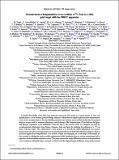Por favor, use este identificador para citar o enlazar a este item:
http://hdl.handle.net/10261/158471COMPARTIR / EXPORTAR:
 SHARE SHARE
 CORE
BASE CORE
BASE
|
|
| Visualizar otros formatos: MARC | Dublin Core | RDF | ORE | MODS | METS | DIDL | DATACITE | |

| Título: | Measurement of fragmentation cross sections of 12C ions on a thin gold target with the FIRST apparatus |
Autor: | Toppi, M.; Abou-Haidar, Ziad CSIC; Álvarez, M. A. G. CSIC; Bocci, A. CSIC ORCID; Cortés-Giraldo, Miguel Antonio CSIC ORCID; Fernández-García, J. P. CSIC ORCID; Pleskac, R.; Sarti, A.; Abou-Haidar, Ziad CSIC; Álvarez, M. A. G. CSIC; Bocci, A. CSIC ORCID; Cortés-Giraldo, Miguel Antonio CSIC ORCID; Fernández-García, J. P. CSIC ORCID; Pleskac, R.; Sarti, A. | Fecha de publicación: | 2016 | Editor: | American Physical Society | Citación: | Physical Review C 93(6): 064601 (2016) | Resumen: | A detailed knowledge of the light ions interaction processes with matter is of great interest in basic and applied physics. As an example, particle therapy and space radioprotection require highly accurate fragmentation cross-section measurements to develop shielding materials and estimate acute and late health risks for manned missions in space and for treatment planning in particle therapy. The Fragmentation of Ions Relevant for Space and Therapy experiment at the Helmholtz Center for Heavy Ion research (GSI) was designed and built by an international collaboration from France, Germany, Italy, and Spain for studying the collisions of a 12C ion beam with thin targets. The collaboration's main purpose is to provide the double-differential cross-section measurement of carbon-ion fragmentation at energies that are relevant for both tumor therapy and space radiation protection applications. Fragmentation cross sections of light ions impinging on a wide range of thin targets are also essential to validate the nuclear models implemented in MC simulations that, in such an energy range, fail to reproduce the data with the required accuracy. This paper presents the single differential carbon-ion fragmentation cross sections on a thin gold target, measured as a function of the fragment angle and kinetic energy in the forward angular region (θ≲6º), aiming to provide useful data for the benchmarking of the simulation softwares used in light ions fragmentation applications. The 12C ions used in the measurement were accelerated at the energy of 400 MeV/nucleon by the SIS (heavy ion synchrotron) GSI facility. | Descripción: | The FIRST Collaboration.-- et al. | Versión del editor: | http://dx.doi.org/10.1103/PhysRevC.93.064601 | URI: | http://hdl.handle.net/10261/158471 | DOI: | 10.1103/PhysRevC.93.064601 | Identificadores: | doi: 10.1103/PhysRevC.93.064601 e-issn: 1089-490X issn: 0556-2813 |
| Aparece en las colecciones: | (CNA) Artículos |
Ficheros en este ítem:
| Fichero | Descripción | Tamaño | Formato | |
|---|---|---|---|---|
| FIRSTapparatus.pdf | 2,03 MB | Adobe PDF |  Visualizar/Abrir |
CORE Recommender
SCOPUSTM
Citations
23
checked on 06-abr-2024
WEB OF SCIENCETM
Citations
19
checked on 22-feb-2024
Page view(s)
255
checked on 16-abr-2024
Download(s)
380
checked on 16-abr-2024
Google ScholarTM
Check
Altmetric
Altmetric
Este item está licenciado bajo una Licencia Creative Commons

